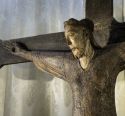Church | XI-XX | Romanesque | Catholic Church




Map
Opening hours
01 January - 31 December
Mon 9.00 - 18.00
Tue 9.00 - 18.00
Wed 9.00 - 18.00
Thu 9.00 - 18.00
Fri 9.00 - 18.00
Sat 9.00 - 18.00
Sun 9.00 - 18.00
Religious offices
from Monday to Satruday : 9 am
Sunday : 11 am
Description
Aywaille had a priory, founded by the monks of Cluny who arrived here in 1088. Jesuits also occupied the place. All these buildings were secularised and sold in 1785. A part of the ancient church served as a base for the construction of the present church, built in local stone. This new church was inaugurated in 1960.
On the outside to the left of the porch, a stone sculpture depicts the crucifixion. The interior gives a wonderful impression of freshness and radiance. Take a look at the fine wooden statue of Peter, the patron saint of the church.
An anecdote: In 1254 Thibauld Visconti from Piacenza (Italy) was appointed prior of Aywaille. He was a well-read theologian, famous to such a degree that he was elected pope in 1271 with the name Gregory X. Thus Aywaille can boast of delivering the Church a pope.
Photos
Remarkable elements
sculptural ensemble
To be seen on the outside, to the left of the portal: a set of sculptures representing a crucifixion: a modern work, made by a pupil of the St Luke's school and acquired by Abbot Jean BAHIM, vicar of Aywaille between 1945 and 1957 and the pioneer of the "Renaissance" of the St. Peter's church.
Cross
To the right of the portal: a cross made in the Dieupart (Aywaille) forges in 1772 and placed on a 13th century base. Before it was placed there, this cross had been placed successively at two other places near Thiry Square in Aywaille.
Modern Virgin in relief
To be seen inside: Modern Virgin in relief, made in the Van den Wildenberg workshops and offered to the church when it was "reopened" in 1960.
17th century Christ
A Christ from the 17th century, probably in the Church of Dieupart before - in the last century - ending up on a cross in the north of the tower. The bad weather conditions have eroded it and the storms have torn it apart. The Christ was perfectly restored by the artist François Compère. The facial expression of the Christ is noble and moving.
Statue of Saint Peter
A statue of St. Peter by Charles Naveau. Research is underway to better determine the origin of this sculpture.
Large cross
A large cross made with period carpentry offered by Mrs Elisabeth Haufroid, a resident of Aywaille. On this cross, a Christ sculpted by an artist from Aywaille: François Compère.




















